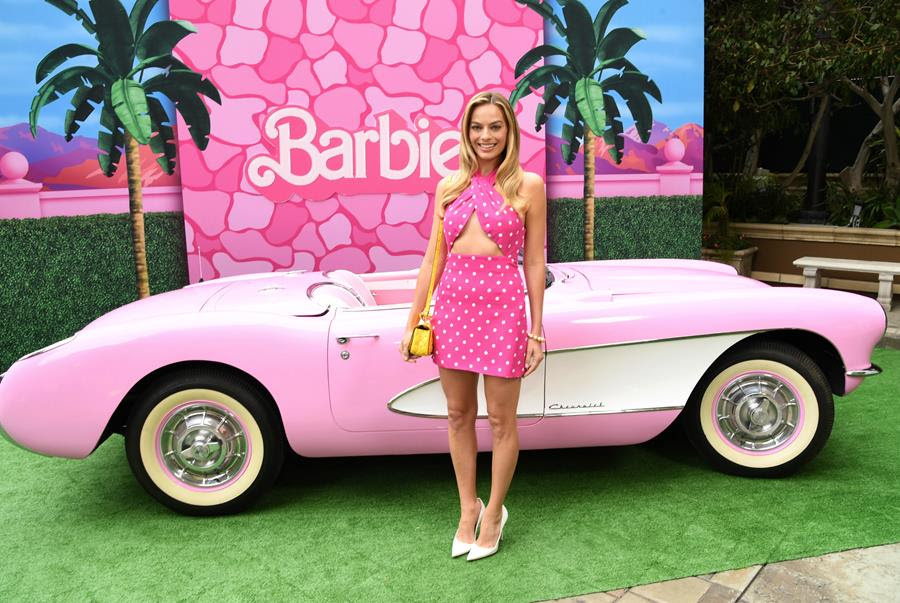Barbie, Child-Free Icon
There’s only one thing this doll hasn’t done. Why, exactly?
By Scarlett Harris
The opening scene of Barbie, the much-anticipated movie event hitting cinemas tomorrow directed by Greta Gerwig and starring Margot Robbie, is a parody of Stanley Kubrick’s 2001: A Space Odyssey. In it, young girls smash their baby dolls in favor of Robbie’s Barbie. Outfitted in the fashion doll’s original get-up of a black-and-white-striped bathing suit, cat-eye sunglasses, and permed bangs, Robbie stands in the center, a glamazon, signaling the dawn of a new woman.
Barbie, the doll, was conceived by Ruth Handler, an executive at Mattel, in the 1950s. After observing her daughter, Barbara, for whom Barbie is named, assigning adult roles to her paper dolls, she came up with the idea—and modeled her creation after a doll based on a German comic strip chronicling the life of a sex worker, Bild Lilli.
Before Barbie hit the market in 1959, dolls for girls were primarily babies meant to teach their owners the caregiving skills they would inevitably need for lives of housewifery and childrearing. But Barbie brought something new: She represented a wide range of fulfilling lifestyles outside of traditional feminine responsibilities. Barbie could be anything she wanted: an astronaut, an artist, even the President. But, in all these years, she’s never wanted to be a mother.
Barbie’s impact has been widely debated, and Barbie leans into this. Is she a feminist icon or nightmare? But one thing cannot be denied: Since her inception, Barbie has been the main character of her own story. She was made to be someone rather than someone’s someone. And in keeping with Barbie tradition, the film’s fantastical Barbieland does away with traditional gender roles. Ken (launched as a boyfriend doll in 1961) lives in service of Barbie, even going so far as to be referenced as “and Ken” in his mugshot—a pure appendage, even if Ken doesn’t have one himself. In a reversal of the biblical creation myth, Ken is spawned from Barbie. “I only exist in the warmth of your gaze,” he says. And, unlike Barbie, he has no occupation—his job is literally described as “beach” in the film.
The message was radical for its time: When the doll debuted, there were few images of female breadwinners. Women couldn’t even get a credit card in their own name without permission from a father or husband until 1974, almost twenty years after Barbie had enjoyed financial independence and career achievement in fields such as modeling (her first occupation), nursing (1961), space and aeronautics (1965 and 1966, respectively), surgery (1973) and Olympic gymnastics (1974).
All those jobs become even more impressive when you consider that, canonically, Barbie is 19 years old. Maria Teresa Hart, the author of the book Doll, points out that her age at the time of her introduction would have put her on the precipice of two possible paths: marriage and babies or continuing her current lifestyle as a Career Girl with a bevy of friends. “That ambiguity is part of the attraction: she’s at this tipping point where she could make a variety of choices,” says Hart. “Every avenue is open to her.”

And yet Barbie never travels down the avenue of parenthood, unless you count the amount of time she spent caring for her sisters, Stacey and Chelsea. (If, during your childhood, Barbie’s youngest sister was named Kelly: congratulations, you’re officially old and missed Kelly’s rebrand as Chelsea in 2011.) Barbie’s childlessness was intentional: Handler wanted to show her daughter that fulfillment can exist outside of the home. In the film, her open-plan, multi-story dream house is a dwelling for one—no child safety, no doors. “It’s very definitely a house for a single woman,” production designer Sarah Greenwood told Architectural Digest.
Barbie’s other accessories weren’t made with would-be kids in mind, either—the Barbie Porsche convertible I had as a child definitely didn’t have a car seat, and the only baby in sight belonged to the much-maligned Midge, a visibly pregnant doll who was discontinued as Barbie’s bestie in 1967, only to reappear later as Barbie’s married mother friend sans baby bump (though she still angered conservative parents who thought she wasn’t coded strongly enough as a married woman). Documentary filmmaker Therese Schechter, who most recently directed the child-free doco My So-Called Selfish Life, expresses incredulity about Midge’s predicament. “No one has children in that world; why is Midge going to have a baby?”
For some, Barbie might still just be a silly doll with an eternally perky and unattainable body. But, as Willa Paskin wrote, Barbie being child-free “remains one of the most radical things about her.” And in a country hell-bent on forcing more and more people to give birth, her childlessness takes on a new and refreshing meaning. As Robbie noted in Vogue, Barbie doesn’t have reproductive organs—which is probably why the elected representatives of Barbieland haven’t tried to police what she does in the Dreamhouse bedroom.
Scarlett Harris is a culture critic and author of the book A Diva Was a Female Version of a Wrestler: An Abbreviated Herstory of World Wrestling Entertainment. You can follow her on Twitter @ScarlettEHarris and read her previously published work at her website, The Scarlett Woman.
